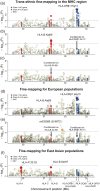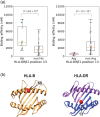Trans-Ethnic Fine-Mapping of the Major Histocompatibility Complex Region Linked to Parkinson's Disease
- PMID: 33973677
- PMCID: PMC8453830
- DOI: 10.1002/mds.28583
Trans-Ethnic Fine-Mapping of the Major Histocompatibility Complex Region Linked to Parkinson's Disease
Abstract
Background: Despite evidence for the role of human leukocyte antigen (HLA) in the genetic predisposition to Parkinson's disease (PD), the complex haplotype structure and highly polymorphic feature of the major histocompatibility complex (MHC) region has hampered a unified insight on the genetic risk of PD. In addition, a majority of the reports focused on Europeans, lacking evidence on other populations.
Objectives: The aim of this study is to elucidate the genetic features of the MHC region associated with PD risk in trans-ethnic cohorts.
Methods: We conducted trans-ethnic fine-mapping of the MHC region for European populations (14,650 cases and 1,288,625 controls) and East Asian populations (7712 cases and 27,372 controls). We adopted a hybrid fine-mapping approach including both HLA genotype imputation of genome-wide association study (GWAS) data and direct imputation of HLA variant risk from the GWAS summary statistics.
Results: Through trans-ethnic MHC fine-mapping, we identified the strongest associations at amino acid position 13 of HLA-DRβ1 (P = 6.0 × 10-15 ), which explains the majority of the risk in HLA-DRB1. In silico prediction revealed that HLA-DRB1 alleles with histidine at amino acid position 13 (His13) had significantly weaker binding affinity to an α-synuclein epitope than other alleles (P = 9.6 × 10-4 ). Stepwise conditional analysis suggested additional independent associations at Ala69 in HLA-B (P = 1.0 × 10-7 ). A subanalysis in Europeans suggested additional independent associations at non-HLA genes in the class III MHC region (EHMT2; P = 2.5 × 10-7 ).
Conclusions: Our study highlights the shared and distinct genetic features of the MHC region in patients with PD across ethnicities. © 2021 The Authors. Movement Disorders published by Wiley Periodicals LLC on behalf of International Parkinson and Movement Disorder Society.
Keywords: Parkinson's disease; HLA; MHC; fine-mapping; trans-ethnic analysis.
© 2021 The Authors. Movement Disorders published by Wiley Periodicals LLC on behalf of International Parkinson and Movement Disorder Society.
Figures



References
Publication types
MeSH terms
Substances
LinkOut - more resources
Full Text Sources
Other Literature Sources
Medical
Research Materials

